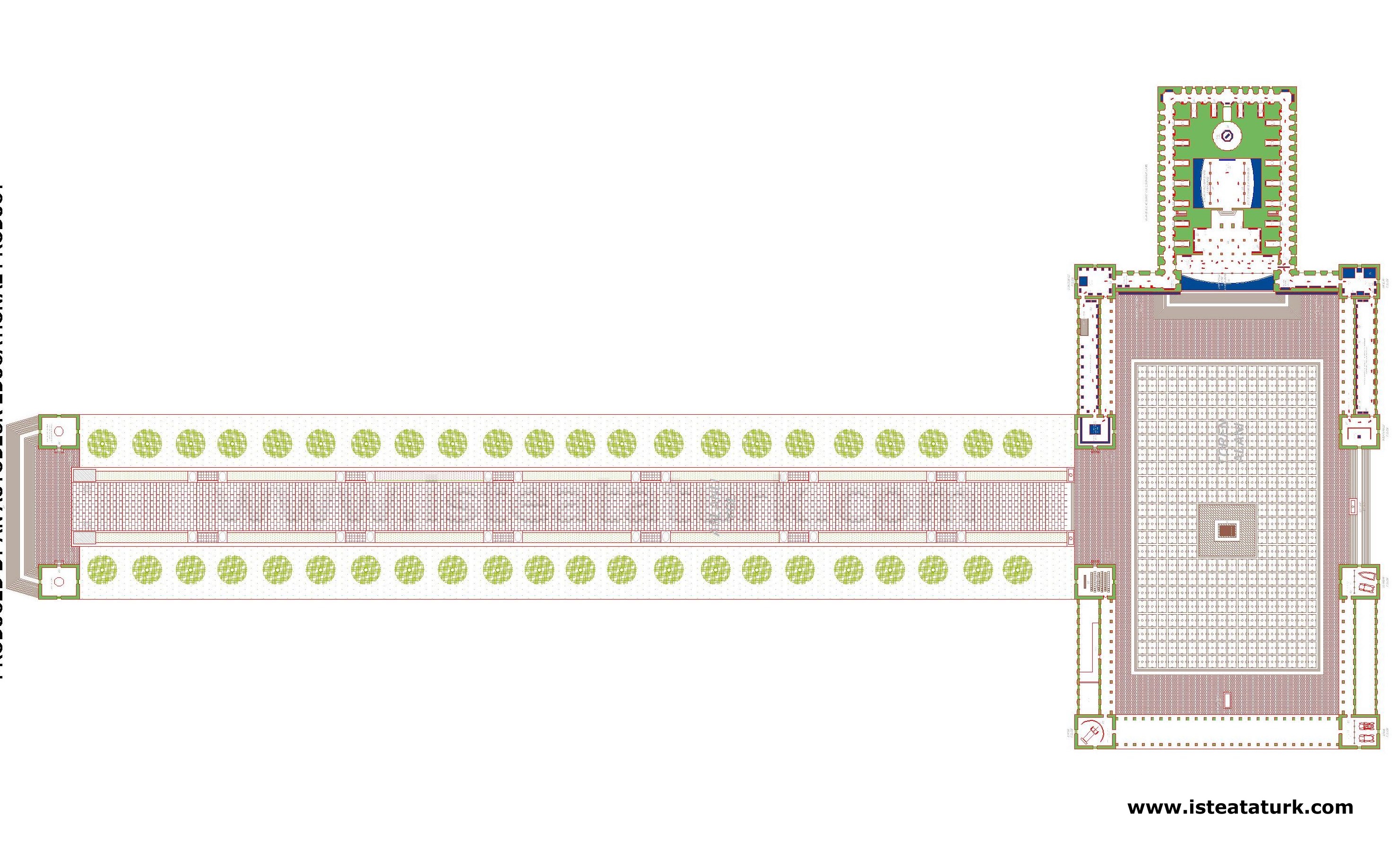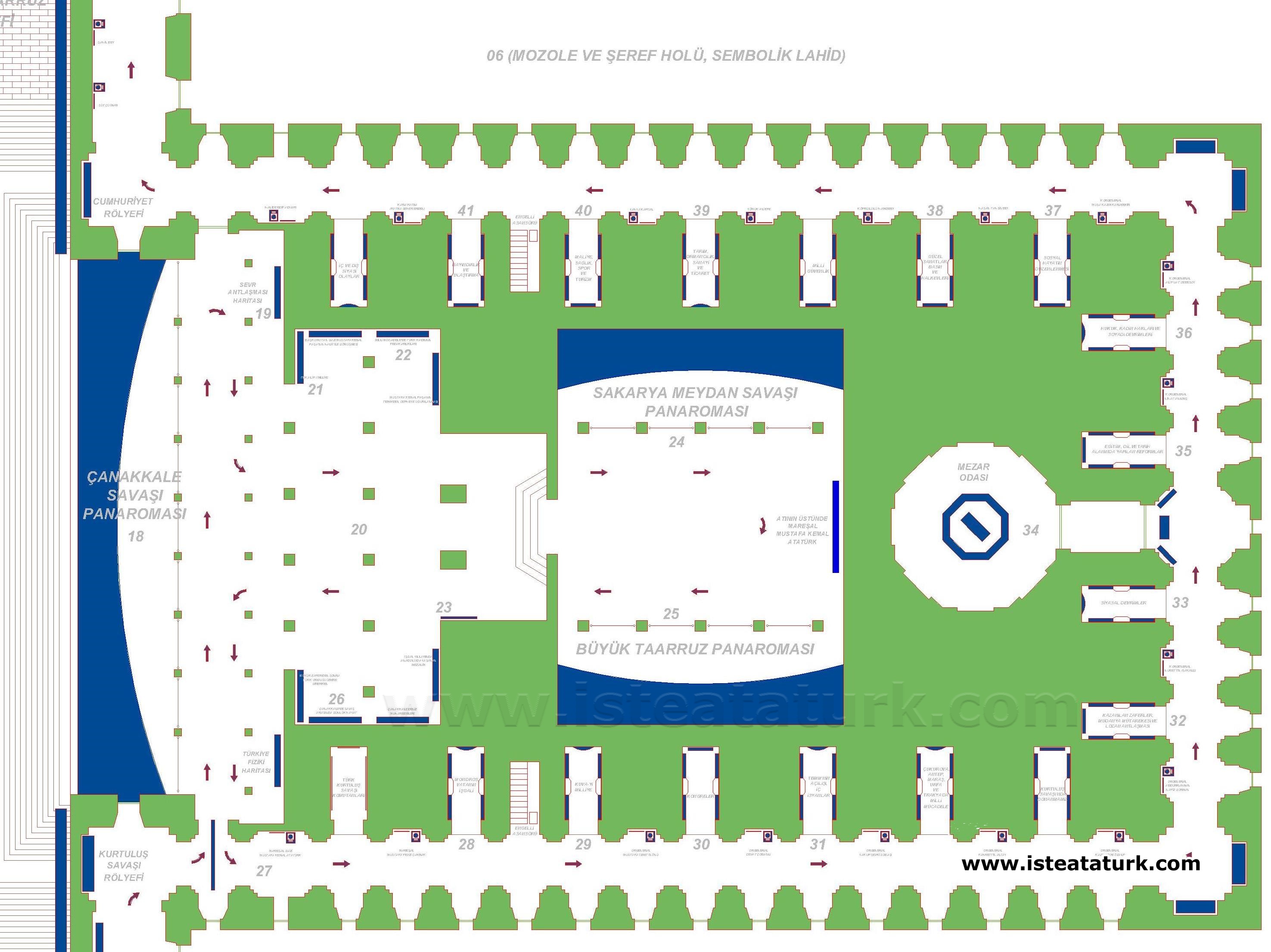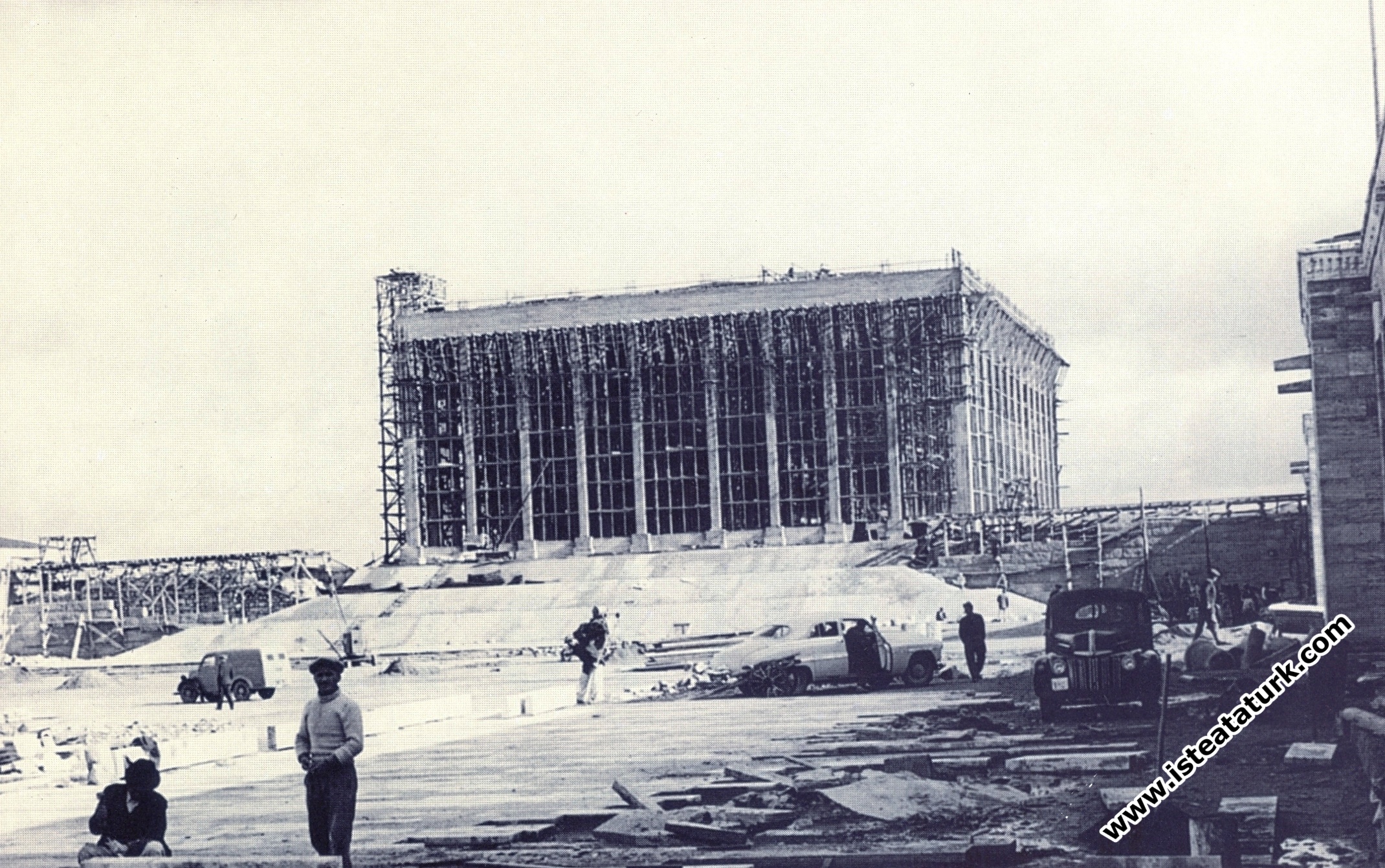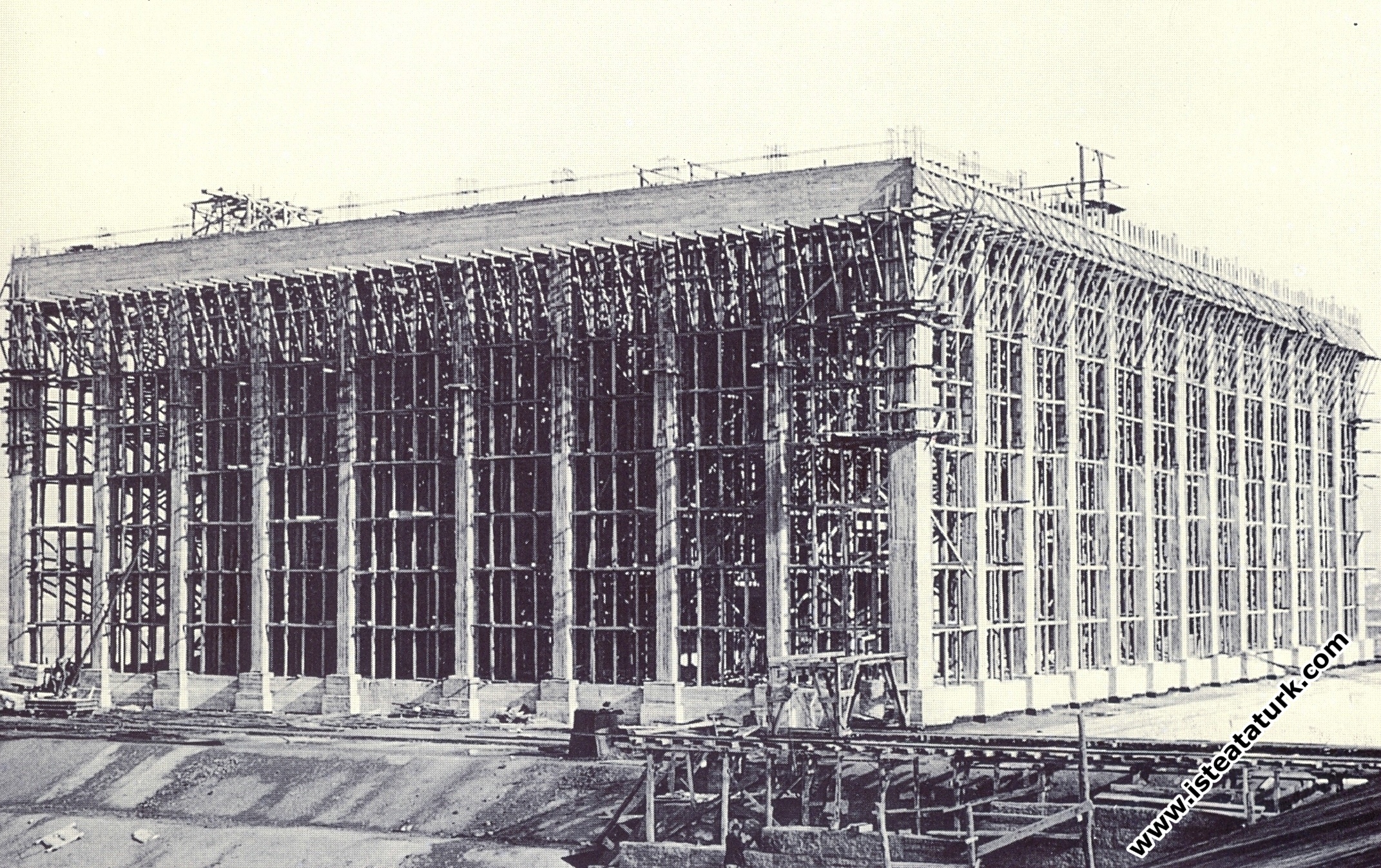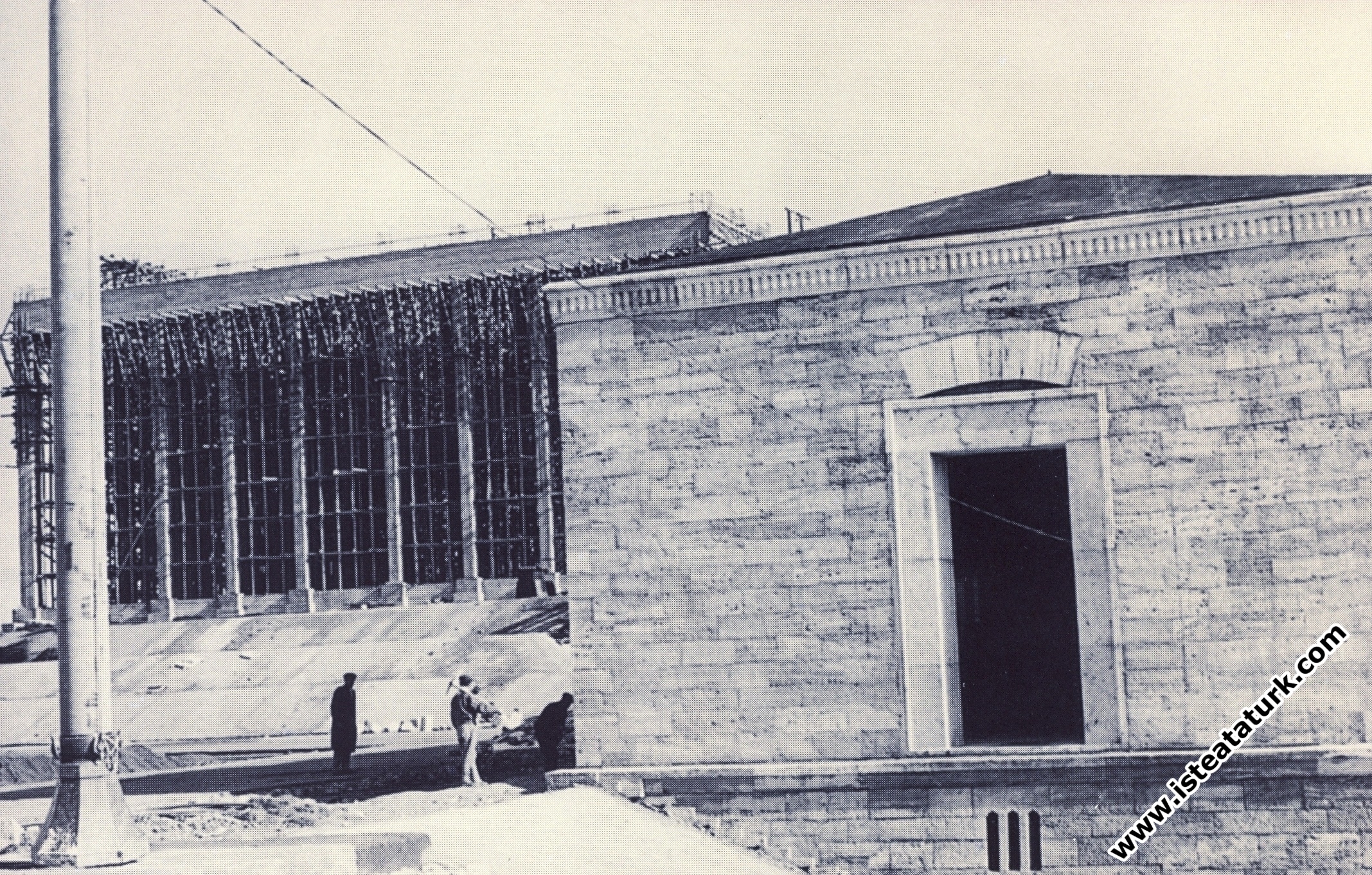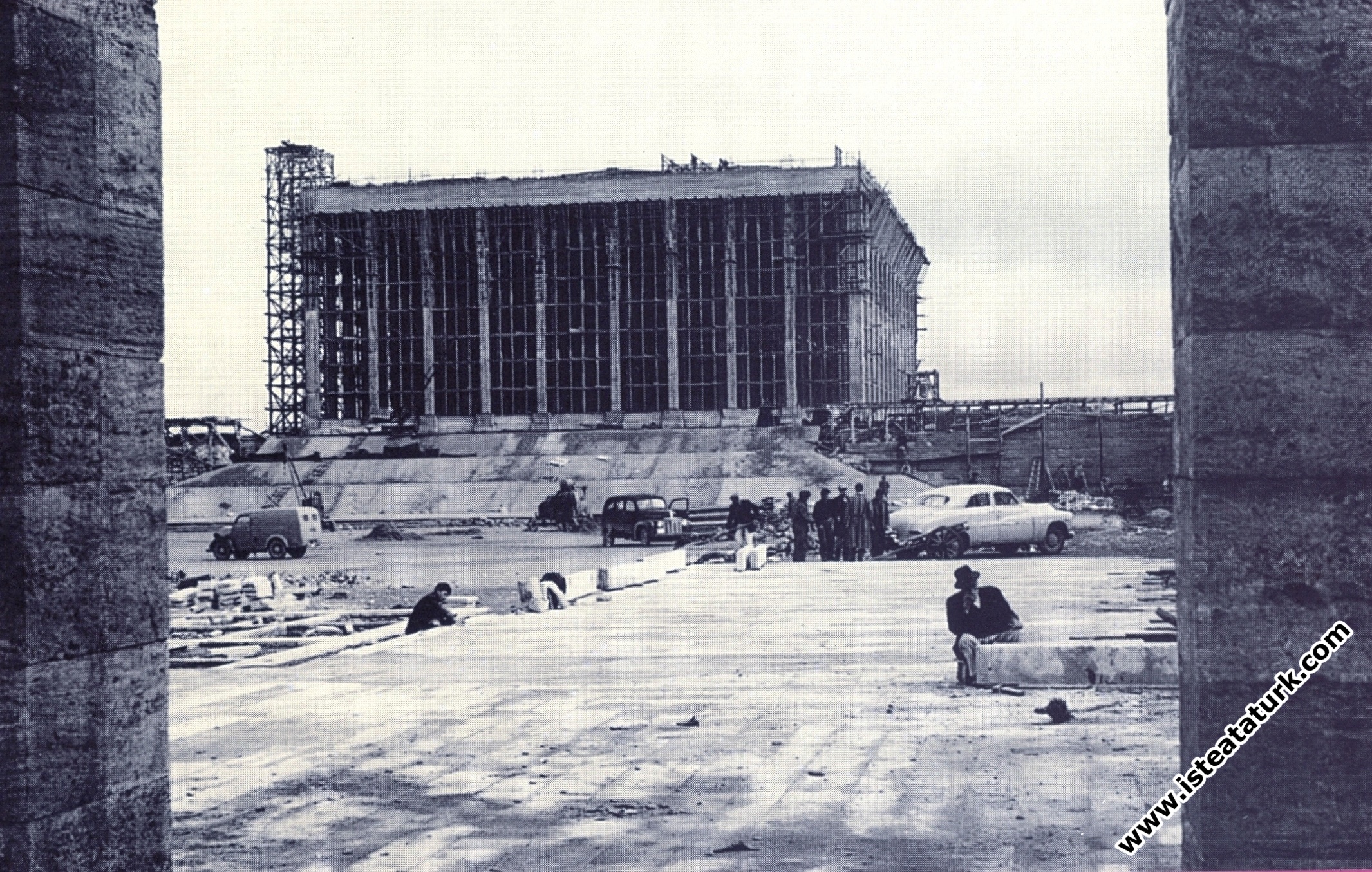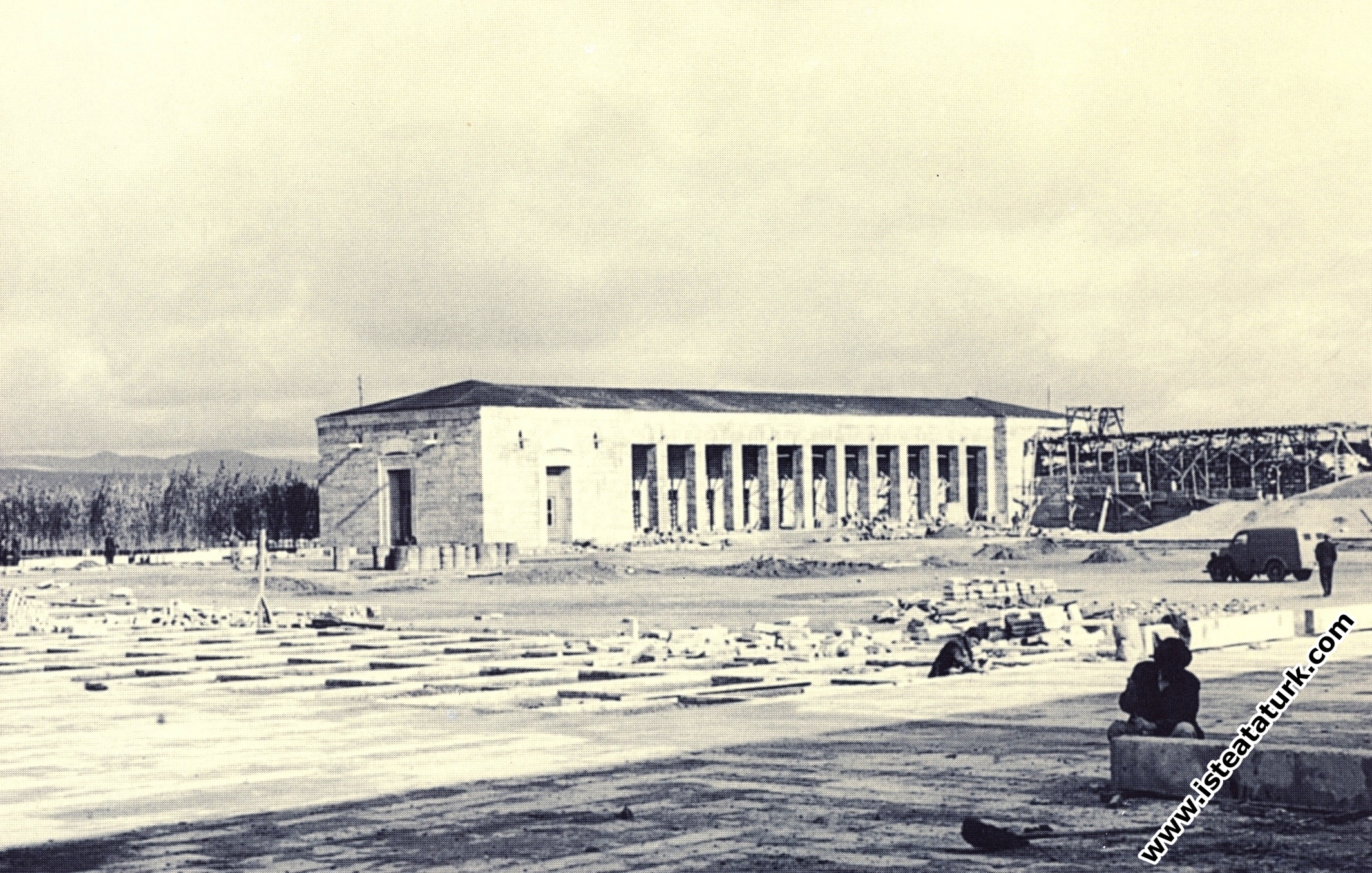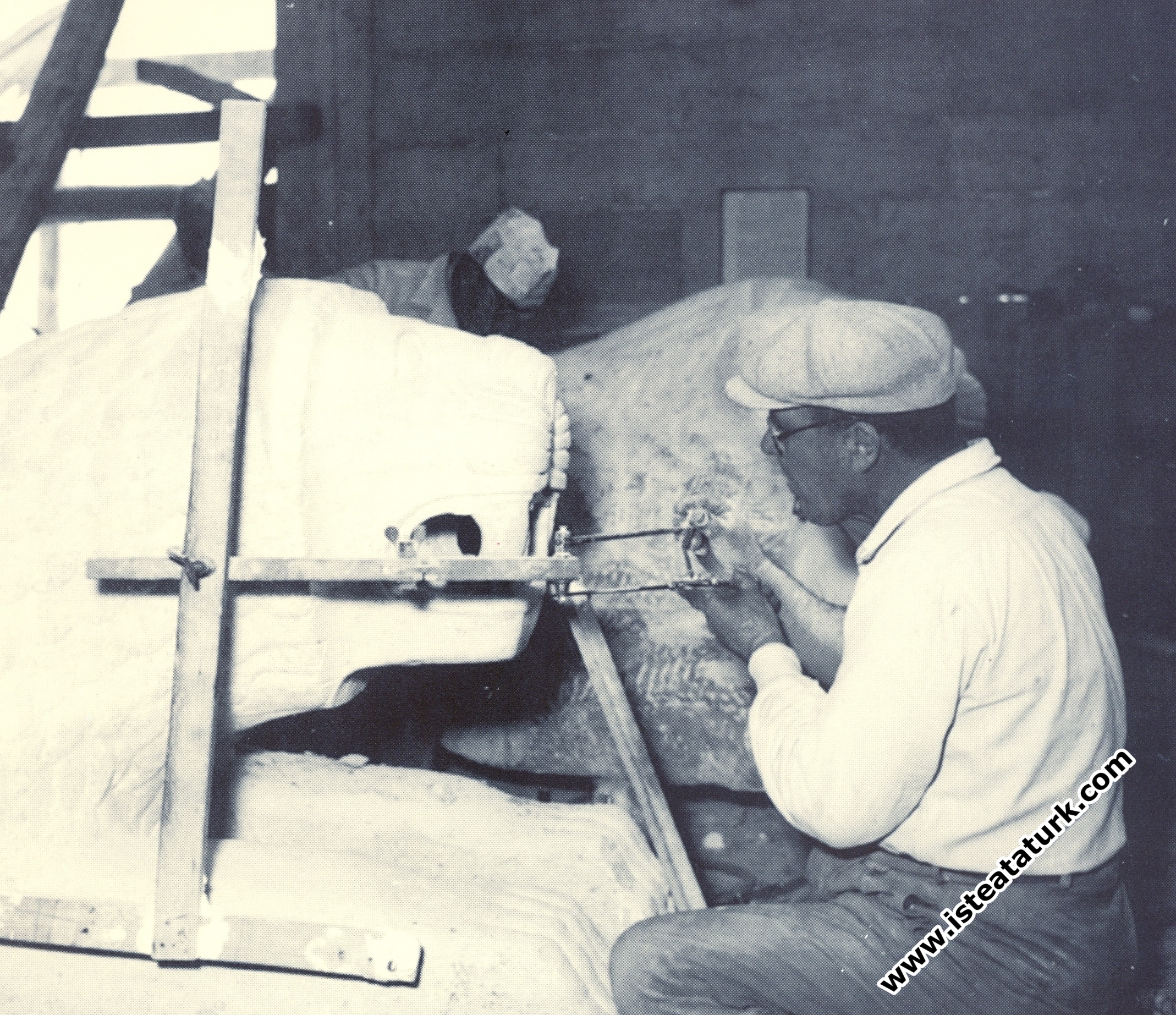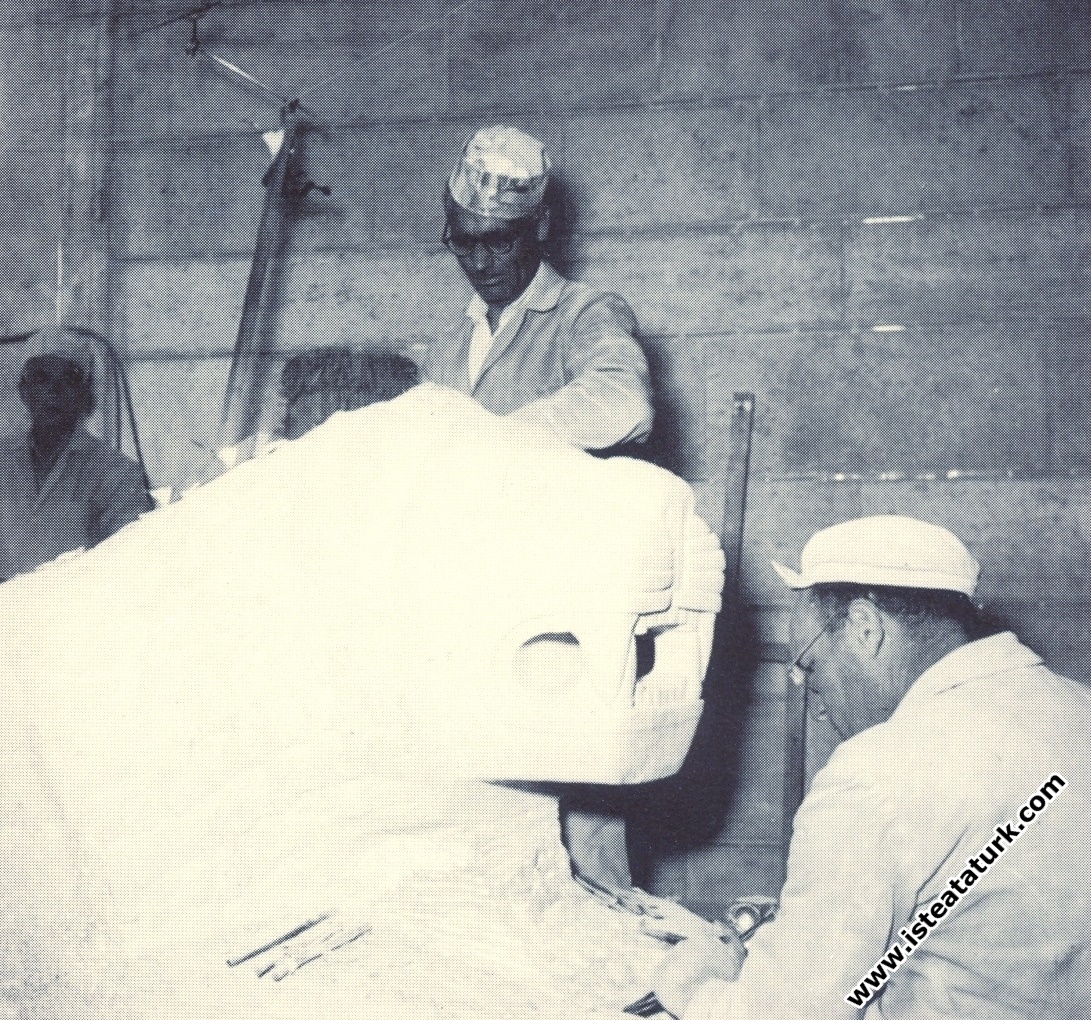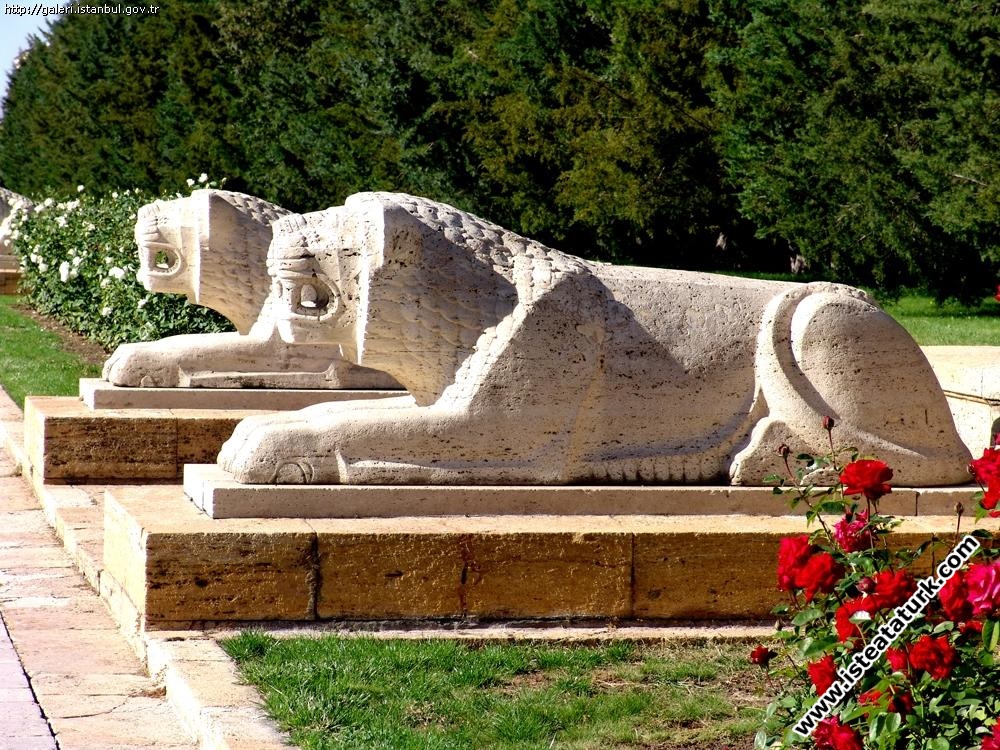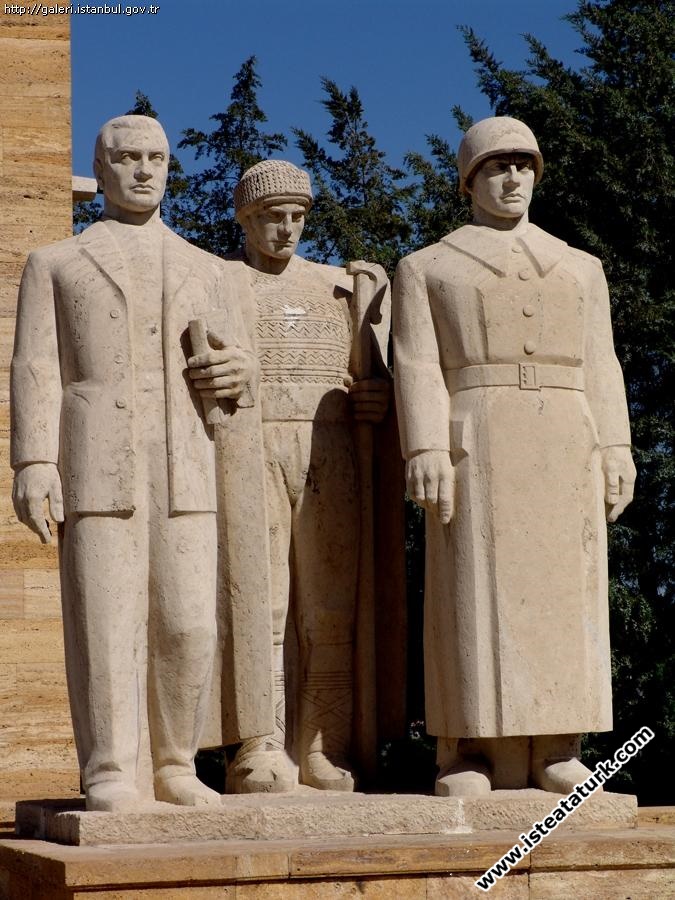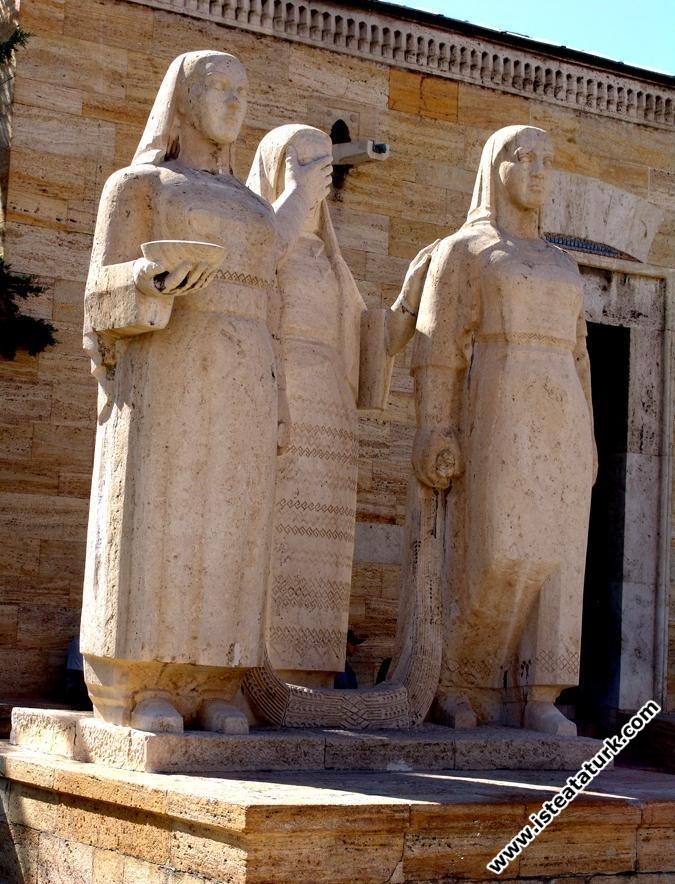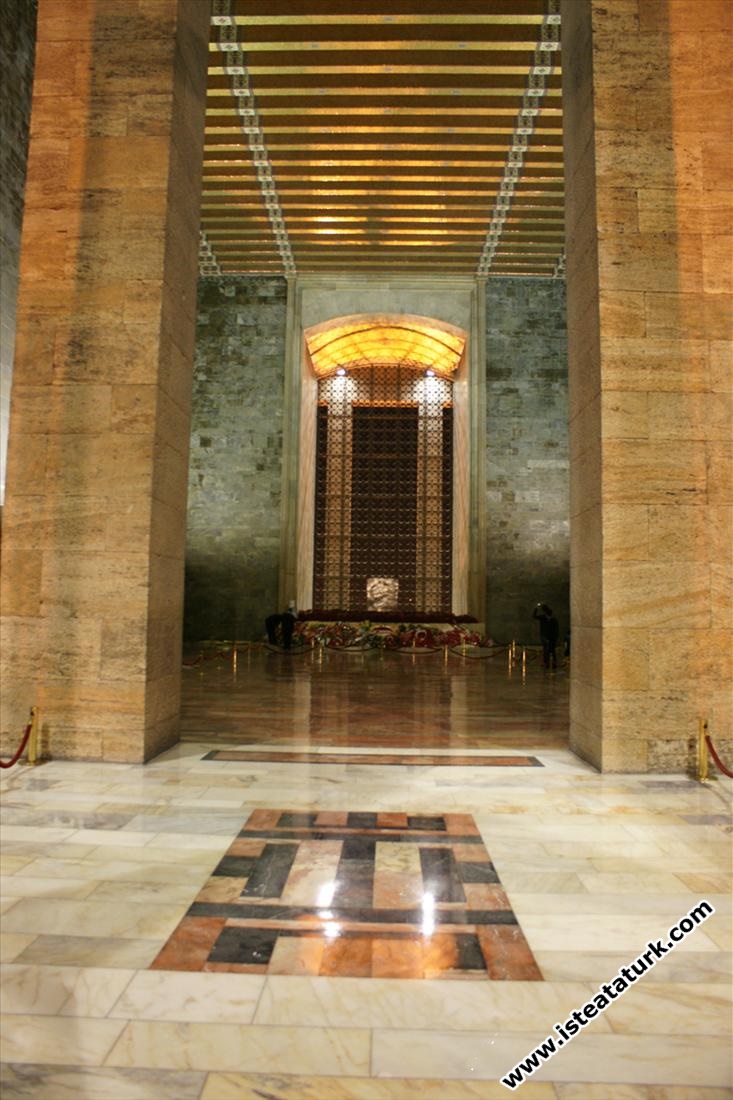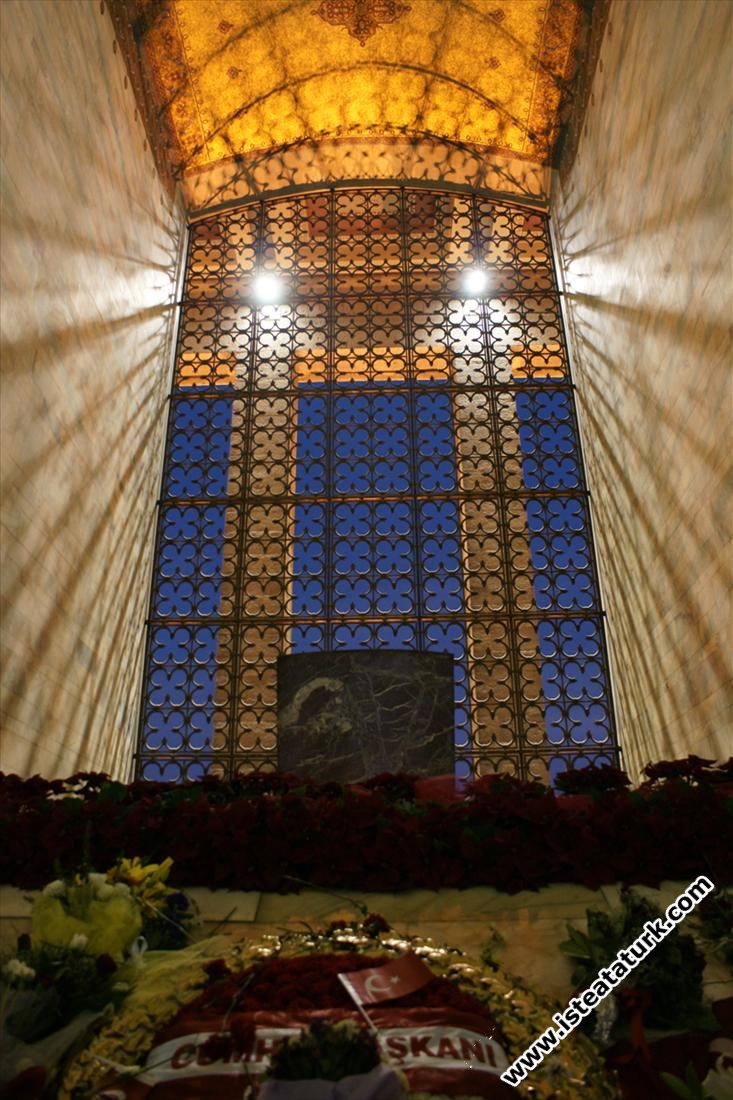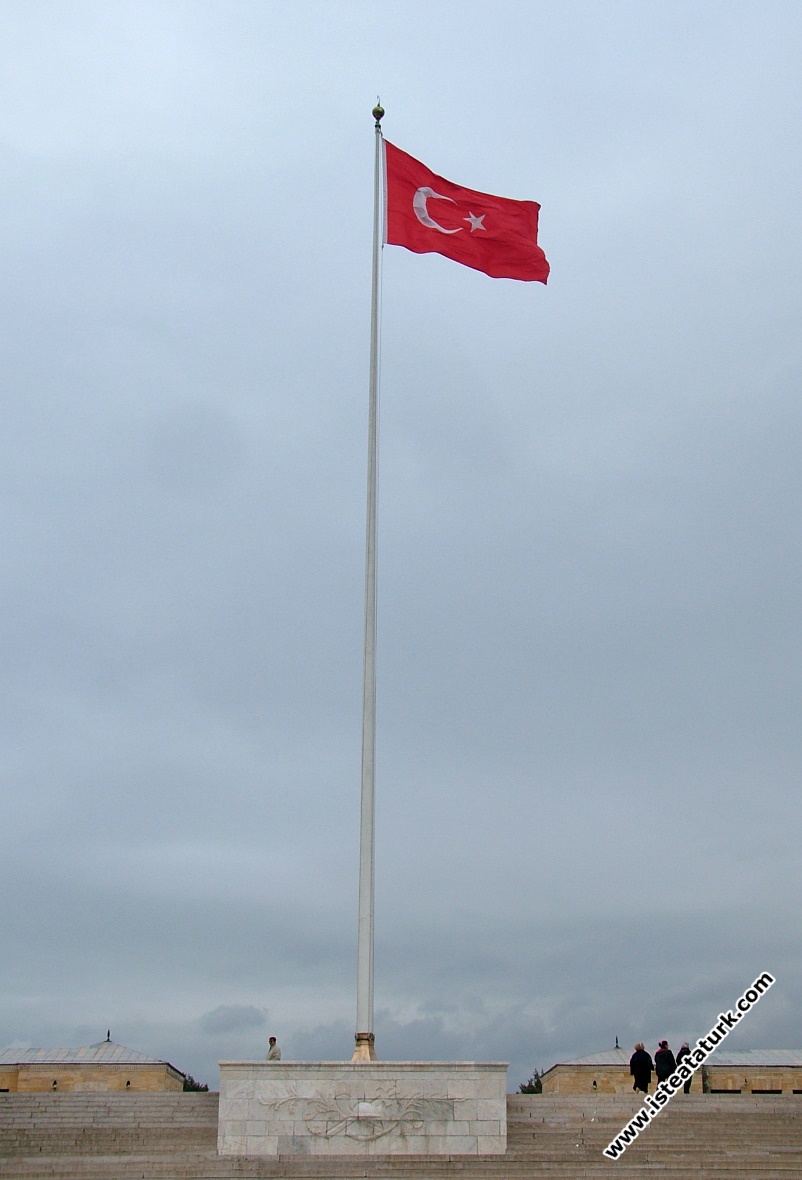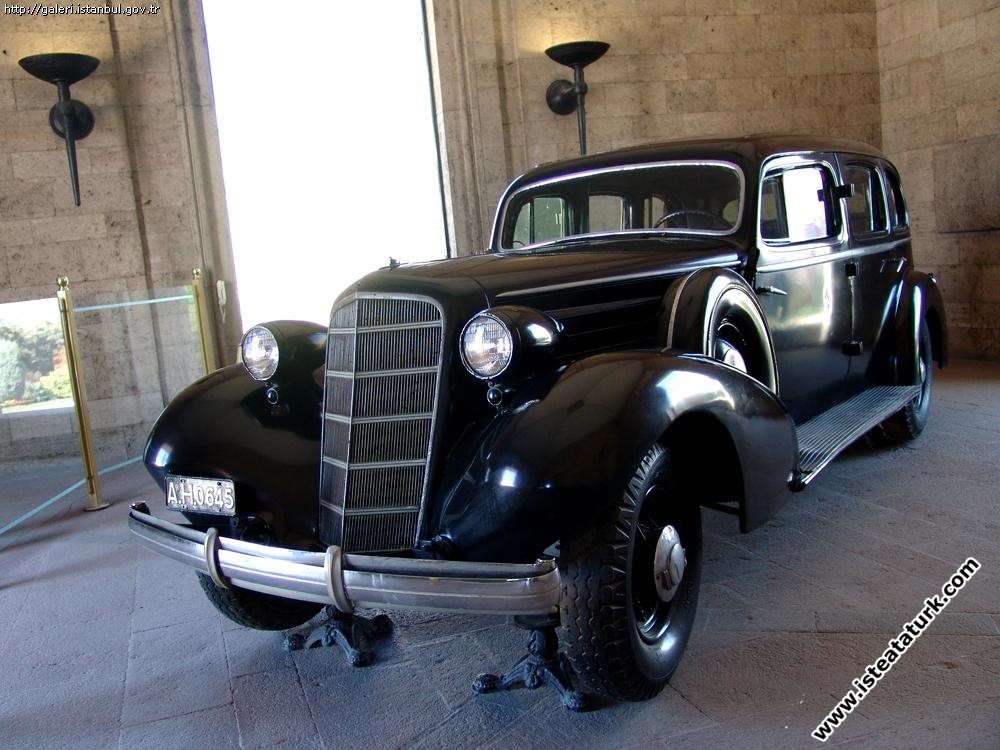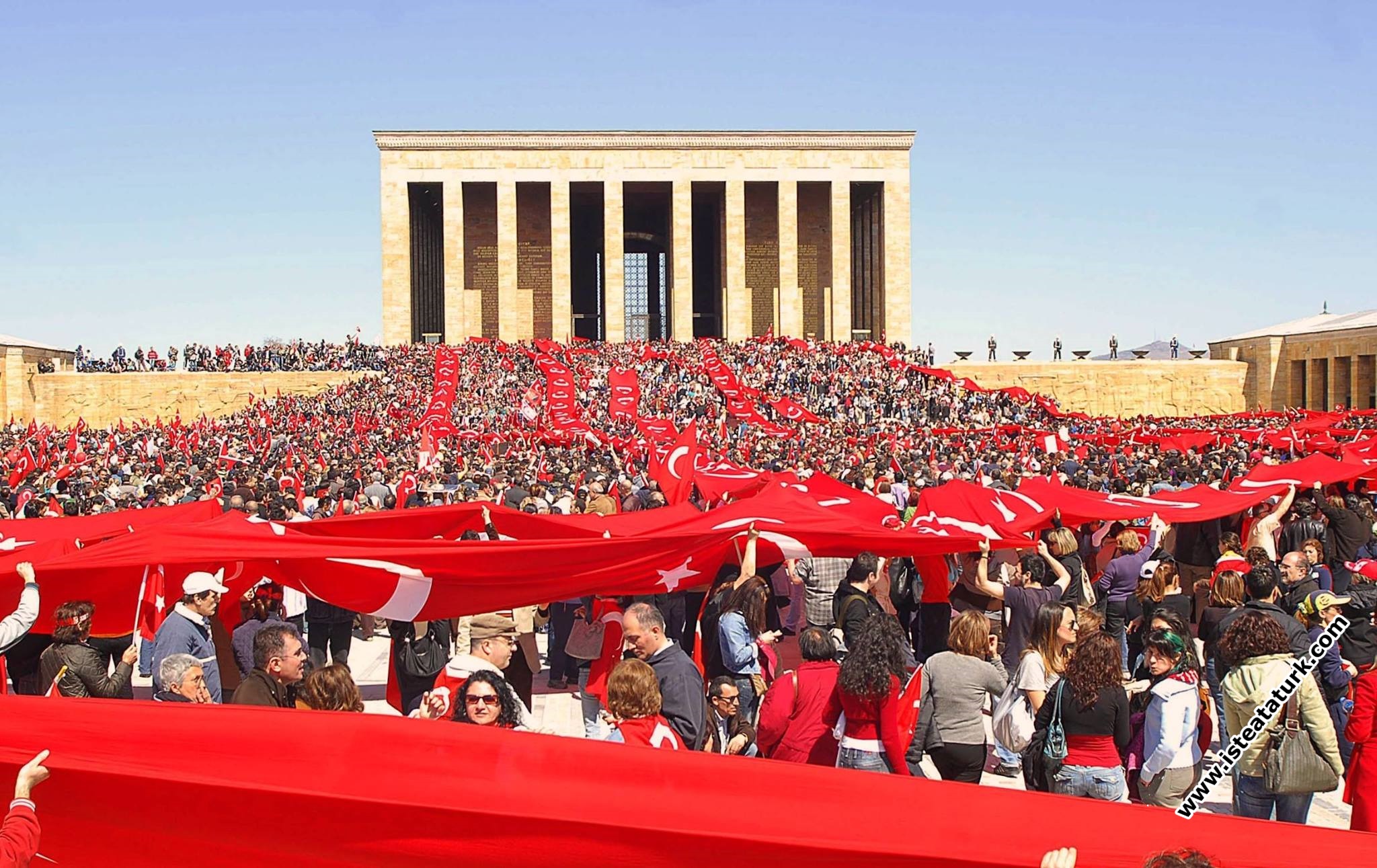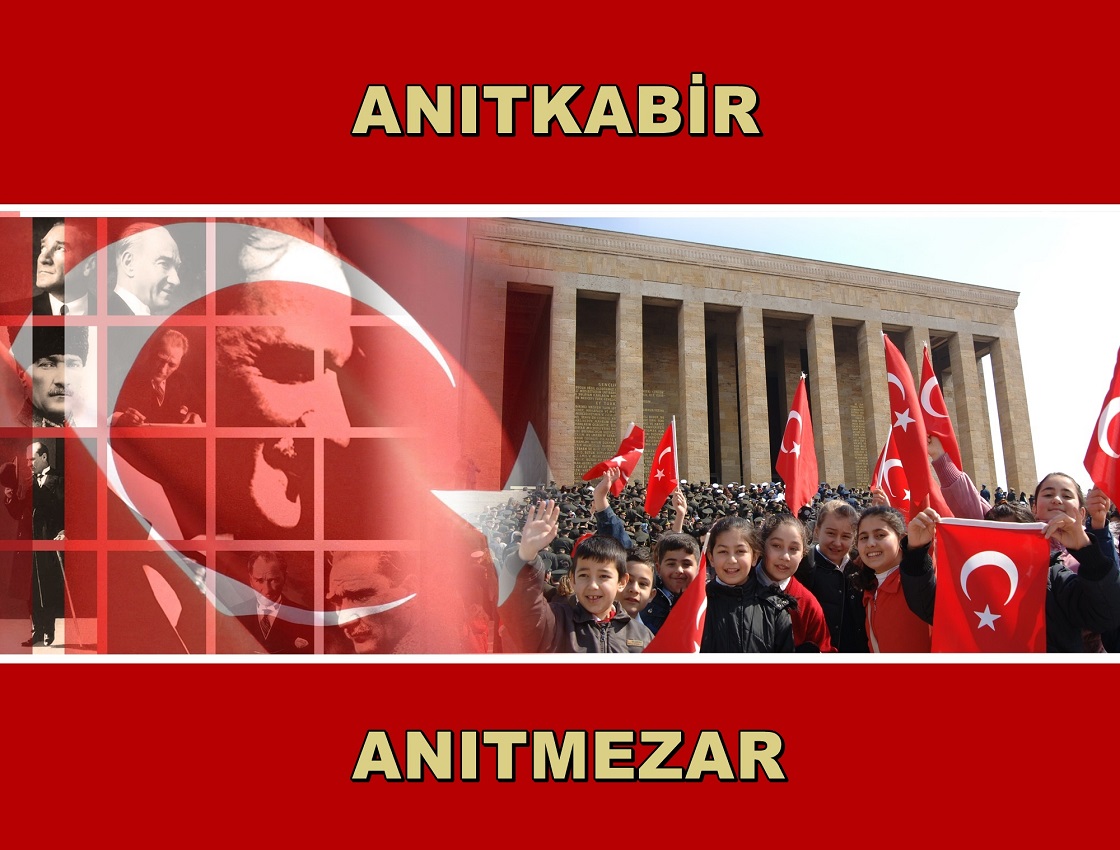
Anıtkabir Mausoleum
Character Size
While visiting Anıttepe, Ataturk said, "What a beautiful monument this hill is," as if he felt that he was going to be buried in Anıttepe. (November 10, 1953)
Anıtkabir, Turkish founder Mustafa Kemal Ataturk's mausoleum located in Ankara, Turkey. It was completed in 1953 and opened to the public the same year. Anıtkabir serves as a tribute to Atatürk's legacy and houses his tomb, as well as a museum displaying his personal effects, photographs, and other items related to his life and accomplishments. The site is visited by millions of people each year and is a symbol of Turkish national pride and unity.
ANITKABIR ... and Its STORY
Throughout history, people have built magnificent tombs in memory of their loved ones who have lost. In the 2nd century BC, the writer Sidon listed the Seven Wonders of the World, among which were the Egyptian pyramids and the mausoleums built by Queen Artemisa in Bodrum for her deceased wife, Mausolos.
Adıyaman Nemrud Mountain, where thousands of local and foreign travelers come and see the morning sun without sleep, and a 1400-meter-long mausoleum with six thousand terracotta figures built for Qin Shi Huang Di, who had the Great Wall of China built, is the wife of Cihan Shah in India. The Taj Mahal he built for the dead was a monumental expression of love and respect for the dead.
Anıtkabir, which looks at the world in all its glory in Ankara, the capital of Turkey, expresses love and respect to Mustafa Kemal Atatürk, the founder and First President of the Republic of Turkey, who revived a nation that was on the verge of being wiped out from the stage of history.
Death is a blood-curdling word. But for Atatürk, there was service to the nation. Death was nothing besides that. When the unit, who wanted to turn the enemy positions in the opposite direction in Çanakkale, fell motionless in the face of the intense fire of the ships, Atatürk broke the siege of death by saying "This is how you pass", shots aimed at killing Atatürk from the enemy units, an exploding piece of bullet smashed the watch he was carrying in his pocket, from Erzurum to Sivas. It was death-defying that he gave the order to continue despite the siege of the brigands. Atatürk stated the following during his speech in Afyon in 1925:
"Friends, this duty of 'serving the nation and the country' will not end. It will continue even after I become a land. I will gladly and happily dedicate my whole being to this sacred duty and I will be happy to take on its high responsibility."
After a year had passed, when the Izmir assassination against him was brought to light, Atatürk called out to the nation with his usual calm and foresightedness and said, "My insignificant body will surely become soil one day. However, the Republic of Turkey will live forever. He will continue to walk on his path without stopping.”
Atatürk knew that the law of nature would not be overturned, and that he himself would become soil like every living thing, he expressed this, and most importantly, he left an undying legacy to the nation: Atatürk's enlightenment. His torch has always come and is running to the aid of the nation in the dark moment.
Atatürk, who passed away on November 10, 1938, did not make a will about the place where he wanted to be buried. Only in 1923, during a conversation, he expressed that he wanted to be buried in Çankaya. He was not insistent on this issue and said, "My nation should bury me wherever it wants to bury me."
A mausoleum worthy of him was thought to be built. First, a special commission was established to find the place where Anıtkabir would be built. In the first meeting of the Commission on December 6, 1938, benefiting from the opinions of local and foreign scientists on the subject of Anıtkabir, urbanism expert Prof. Jahsen, the architect of the Parliament building Prof. Holzmeister and the architect of the Faculty of Language, History and Geography building, Prof. It was decided that Taut's views should also be taken. With the participation of these scientists, the commission held its second meeting on 16 December 1938. Suggested places were: Çankaya, Ethnography Museum, the hill behind the TBMM (Kabatepe), Ankara Castle, Ministries (the plot allocated for the Ministry of National Education), Old Agricultural School, Youth Park, Altındağ (Hıdırlık Hill), Gazi Forest Farm. The proposed places were not found suitable for reasons such as historical or green areas, being in the city center or very far from the center.
In the last commission meeting on 17 January 1939, Trabzon Deputy Mithat Aydın explained the characteristics of Rasattepe, which he saw as a place worthy of Anıtkabir. The hill was in the middle of the city and was high enough to make the Anıtkabir to be built here visible from afar. Kütahya Deputy Süreyya Özgeevren, one of the members of the commission, explained the very favorable features of Rasattepe for Anıtkabir and concluded her speech as follows:
"According to the general appearance of Ankara today and tomorrow, Rasattepe is like a star in the middle of a crescent with one end in Dikmen and the other in Etlik. If Anıtkabir is accepted to be built here, the city of Ankara, the capital of Turkey, will spread its arms. Thus, we will have laid Atatürk in the middle of the half-moon star on our flag."
Icel Deputy Emin Inankur, who spoke at the commission, said that they went to Rasattepe on a city tour with Ataturk, and Ataturk watched the city from here and said, "What a beautiful monumental place this hill is." After these explanations, the construction of Anıtkabir in Rasattepe was accepted by the majority.
After his place was decided, the commission determined the general qualifications that should be found in Anıtkabir. These principles became the basis of the Anıtkabir project competition specifications. Anıtkabir Free Project Competition specifications were prepared in Turkish and French in accordance with the international architects' charter, and the competition was opened by the government on March 1, 1941. The year the competition opened was the bloodiest, most difficult time of the Second World War. Parts of Europe, Asia and Africa were at war. The world was on fire. The duration of the competition was 8 months. Since it was understood that the Anıtkabir project could not be completed in this short time, the period was extended by the Council of Ministers for another 4 months. An impartial jury was formed for the competition, consisting of internationally known local and foreign artists and architects determined by the Ministry of Public Works. The competition received more attention than expected. A total of 47 projects from Turkey, Germany, Italy, Austria, Sweden, France and Czechoslovakia participated in the competition. Three of these projects were led by Prof. Johannes Kruger, Prof. Emin Onat and Assoc. Orhan Arda and Prof. Arnaldo Foschini's designs were awarded, 5 of them; The designs of Ronald Rohn from Switzerland, Giovanni Muzio from Italy, Giuseppe Vaccaro - Gino Franzi, Hamit Kemali Söylemezoğlu - Kemal Ahmet Aru - Recai Akçay and Ferudun Akozan - M. Ali Handan from Turkey were praised. The jury did not consider any of the three works to be "worthy of an award" superior to the other. The authority to choose one of these three works was given to the government in accordance with the terms of the Anıtkabir Project Competition.
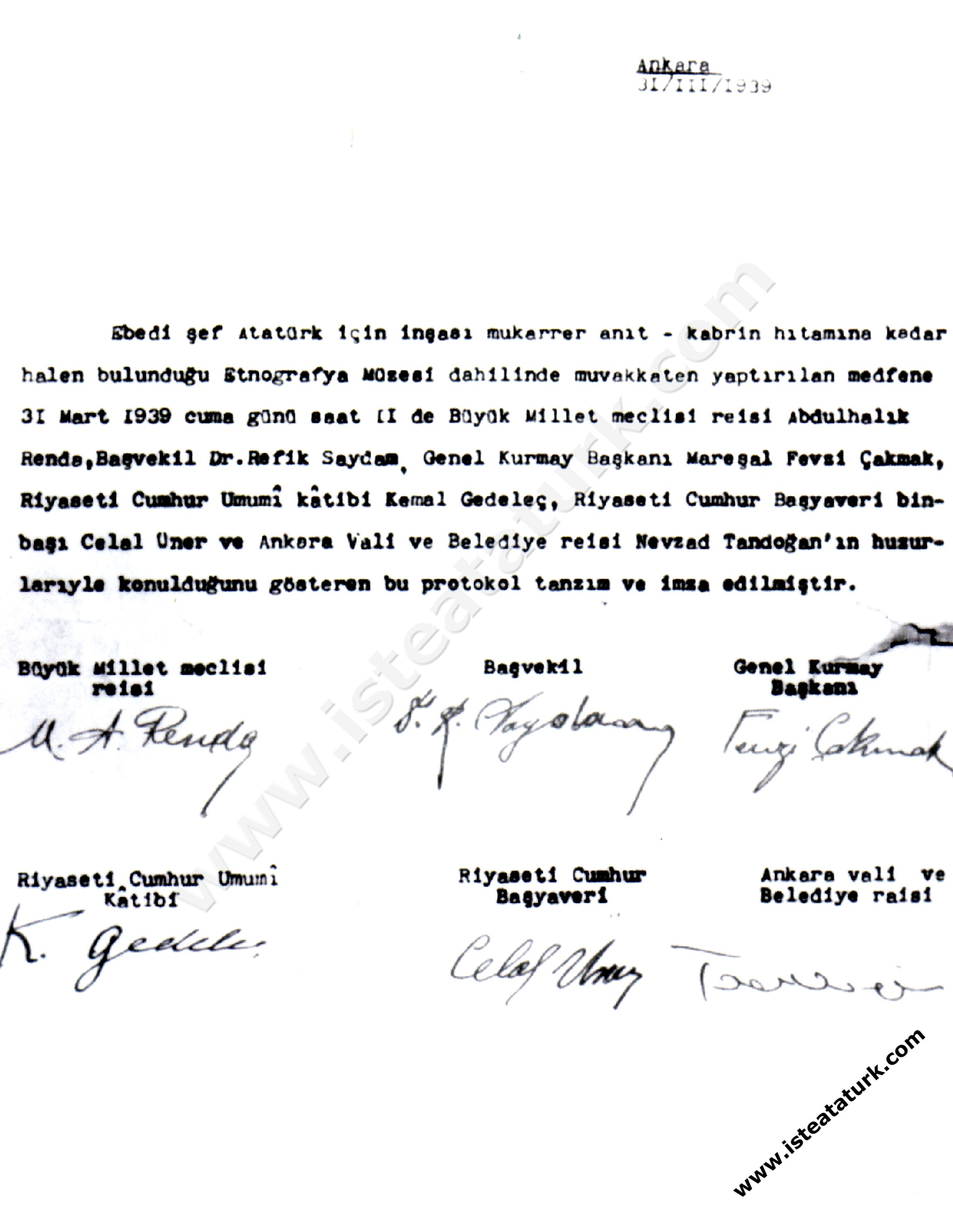
Protocol on the construction of Anıtkabir, dated March 31, 1939.
After this decision, a new commission was established to make the foreseen changes in the jury report. Changes to be made in the project. Emin Onat and Assoc. It was decided by meeting with Orhan Arda. In the project, the axis of the castle and the sections around the honor hall were criticized for losing the monumental quality of the building. prof. Emin Onat and Assoc. Orhan Arda completed his work on 7 October 1943 and handed it over to the commission. The report, projects and models prepared by the commission were examined by the Council of Ministers and the implementation of the project was decided on 18 November 1943. It started with a magnificent groundbreaking ceremony on October 9, 1944. The construction of Anıtkabir was done in 4 phases over a period of 9 years. The temporary tomb of the Great Leader in the Ethnography Museum, where he stayed for 15 years, was opened on 4 November 1953. From November 4 to November 9' A vigil of respect was held until On November 10, 1953, 15 years after his death, Atatürk's body was moved to Anıtkabir, a gift from his nation, in tears. After the official ceremony, Anıtkabir was opened to the public, and the monument was illuminated with floodlights at night. On November 19, 1953, 70,000 people visited Anıtkabir. Atatürk met with those who wanted to see him in 1929;
"Seeing me means seeing my face no matter what. If you understand and hear my thoughts, my feelings, that's enough. For you, this man who has dedicated his health, his life, is healthy and will work for you. He lives for you. My strength is my love for you and yours. It is your love for me. This nation, this country will be the most plausible presence in the world on the new form of government." he said.
Atatürk, who established a throne in our hearts by "winning hearts, not by breaking hearts" in human relations, also showed us the way to be followed in order for life to be full of happiness:
"What is necessary for anyone to be proud and happy as long as they live is to work not for themselves, but for those who will come after them. Full pleasure and happiness in life can only be found in working for the dignity, existence and happiness of future generations. When a person acts like this, he says, 'I wonder if they will come after me? Will they discern that I work with the spirit?' Moreover, the happiest are those who are self-confident who would prefer their service to remain unknown to all generations.”
Source: Sinem Şahinoğlu, Whole World, November, 2001
II
ANITKABIR MEMORIAL
The life of Mustafa Kemal Atatürk, the founder of the Turkish Republic, the great leader of the Turkish War of Independence and the Turkish Revolutions, with the war he started for the independence of the Turkish homeland and the revolutions he carried out to bring the Turkish nation to the level of modern civilization, lasted 57 years and the Great Leader was born on November 10, 1938. has passed into eternity.
Mustafa Kemal Atatürk is a great leader who has made Turkey a member of modern civilization with all its institutions and has cost the history of humanity. The idea of building a mausoleum that would represent his greatness in all aspects, reflecting his principles and reforms and his thoughts on modernization emerged as the common desire of the Turkish nation in the deep sorrow of losing Atatürk, and it was decided to be built.
RASATTEPE (ANITTEPE)
The name of Anıttepe was Rasattepe because there was an observation station before the Anıtkabir was built.
On this hill, there were tumuli (tomb structures) belonging to the Phrygian Civilization, which established a state in Anatolia in the 12th century BC. After it was decided to build Anıtkabir in Rasattepe, archaeological excavations were carried out to remove these tumuli. The artifacts unearthed from these tumuli are exhibited in the Museum of Anatolian Civilizations.
Anıtkabir from the sky
CONSTRUCTION OF ANITKABIR
After the determination of the Anıtkabir project, the expropriation works were started in the first stage so that the construction could begin. The construction of Anıtkabir began on October 9, 1944, with a magnificent groundbreaking ceremony. The construction of Anıtkabir was carried out in four phases over a period of nine years.
First Part Construction: 1944 - 1945
Construction of the first part, which includes the soil level and the retaining wall of the Aslanlı road, started on 9 October 1944 and was completed in 1945.
Second Part Construction: 1945 - 1950
The second part, which includes the construction of the mausoleum and the auxiliary buildings surrounding the ceremonial square, started on 29 September 1945 and was completed on 8 August 1950. At this stage, it was decided to prepare the "foundation project" of the monument mass, taking into account the reduction of the foundation pressure, according to the masonry and reinforced concrete structure system of the construction. By the end of 1947, the foundation excavation and isolation of the mausoleum was completed and the iron assembly of the 11-meter-high reinforced concrete foundation system, which will prevent all kinds of collapses, has come to the stage of completion. An important part of the entrance towers and road layout, nursery establishment, afforestation works and a large part of the irrigation system of the land have been completed.
Third Part Construction: 1950
The construction of the third part of the Anıtkabir consisted of the roads leading to the monument, the lion road, the ceremonial square and the stone pavement of the mausoleum, the construction of the stairs, the replacement of the sarcophagus and the installation works.
Fourth Part Construction: 1950 - 1953
The construction of the 4th part of Anıtkabir included the floor of the honor hall, the lower floors of the vaults, and the stone profiles and eaves decorations around the honor hall. Construction of the fourth phase started on 20 November 1950 and was finished on 1 September 1953.
In the "Anıtkabir Project", there was a vaulted section rising above the colonnade of the mausoleum. On December 4, 1951, the government asked the architects whether it would be possible to complete the building more quickly by reducing the height of the hall of honor by 28 meters.
At the end of their studies, the architects reported that it was possible to cover the honor hall with a reinforced concrete ceiling instead of a stone vault. Thus, the weight of the vault structure on the floor and the technical drawbacks it would cause were eliminated.
In the construction of Anıtkabir, porous, various colors of travertine were used as exterior coating material on concrete, and marble was used in the interior coatings of the mausoleum.
The white travertines used in the sculpture groups, lion statues and mausoleum columns were brought from Kayseri Pınarbaşı District, and the white travertines used on the inner walls of the tower were brought from Polatlı and Malıköy. Black and red travertines brought from Kayseri Boğazköprü region were used in the flooring of the ceremonial square and towers, and yellow travertines brought from Çankırı Eskipazar were used in the construction of the victory reliefs, the outer walls of the honor hall, the walls and the columns surrounding the ceremonial square.
The cream, red and black marbles used on the floor of the hall of honor were brought from Çanakkale, Hatay and Adana, the tiger skin used on the inner side walls of the hall of honor was brought from Afyon, and the green marble was brought from Bilecik. The monolithic sarcophagus weighing 40 tons was brought from Osmaniye District of Adana, and the white marble covering the side walls of the sarcophagus was brought from Afyon.
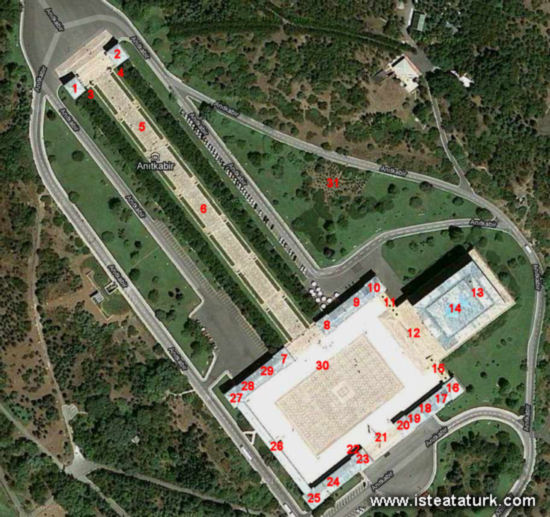
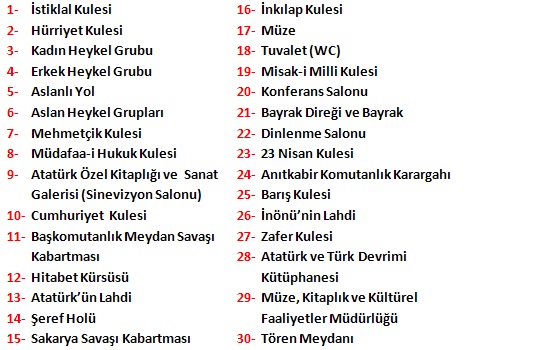
Anitkabir Layout Plan
Architectural Features of Anıtkabir
In Turkish architecture, the years between 1940 and 1950 are called the "II. National Architecture Period". In this period, buildings with a predominant monumental aspect, giving importance to symmetry and using cut stone materials were built. Anıtkabir bears the characteristics of this period.
Along with the features of this period, Seljuk and Ottoman architectural features and decorative elements are frequently encountered in Anıtkabir.
For example, on the exterior, where the walls meet the roof, there is a border that surrounds the towers on all four sides, which is called sawtooth in Seljuk stonemasonry. In addition, stone ornaments called passionflower and rosettes used in some parts of Anıtkabir (Mehmetçik Tower, Museum Directorate) are also striking in Seljuk and Ottoman art.
Anıtkabir, which is one of the best examples of the period it was built with all these features, covers an area of approximately 750,000 m² and is divided into two parts as the Peace Park and the Monument Block.
Peace Park
Mausoleum; It rises in the Peace Park, which was created with saplings brought from various foreign countries and some regions of Turkey, inspired by Atatürk's motto "Peace at Home, Peace in the World" .
Various from Afghanistan, USA, Germany, Austria, Belgium, China, Denmark, Finland, France, India, Iraq, England, Spain, Israel, Sweden, Italy, Japan, Canada, Cyprus, Egypt, Norway, Portugal, Yugoslavia and Greece trees and saplings were brought. Today, there are approximately 48,500 ornamental trees, shrubs and ornamental plants from 104 different species in the Peace Park.
Countries that donated trees to the Peace Park and the trees they donated:
Afghanistan : 15 Akkavak, 10 Nesteren Rose, 12 Chitlembik, USA : 310 Blue Spruce, 100 Blue Cypress, 100 Cedar, Austria : 55 Mountain Pine, West Germany : 25 Marsh Oak, 10 Birch, 15 Linden, 5 Atlas Cedar, 5 Liar Cypress, 8 Pinus Sabiniana, 17 Plum, 5 Horizontal Juniper, 200 Rose, Belgium : 10 Cotoneaster, 13 Boxwood, 12 Thuja 12 Horizontal Juniper, 12 Cedar, 12 Maple, 12 Yew, 12 Fir, 12 Scots Pine, Denmark : 20 Beech, Finland : 275 Birch, France : 10 Alder, 10 Scots Pine, 10 Beach Pine, 10 Peanut Pine, 10 European Hybrid, 10 Fir, 10 Beech, 10 European Spruce, China : Some Armand Pine and Chinese Fir seeds, India : 289 Beach Pine, Iraq : 20 Mosul Pistachio, England : 50 Cherry, 50 Yew, 100 Larch, 50 Oak, Spain : 1 Elm, 1 Cypress, 4 Beach Pine, 1 Ash, 2 Chestnut, 3 Juniper, 1 Walnut, 1 Oak, Israel : 30 Beach Pine, Italy : 5 Blackberry, 5 Cemetery Cypress, 8 Pine Pine, 10 Blue Cypress, 5 Larch, 7 Cedar, Japan : 35 Cherry, Canada : 30 Maple, Cyprus : 5 Pine, Egypt : 8 Akkavak, 6 Catalpa, 6 Gladicia, 6 Acacia, 6 Salkım Acacia
Monument Block
Anıtkabir Monument Block consists of three parts.
Lion Road, Ceremonial Square, Mausoleum.
When you enter Anıtkabir through the Tandoğan gate, you can reach the 26-step wide stairs at the beginning of Aslanlı Yolu from the road extending in Barış Park. At the beginning of the stairs, there are towers of independence and freedom, facing each other.
There are ten towers in the Anıtkabir building complex, which were placed in symmetry. These towers have been given names representing lofty concepts that have had great influence on the formation of our nation and state. The towers are similar to each other in plan and structure. 12x14x7.20 m, close to a square. The towers, which were built on a rectangular plan, are covered with pyramid-shaped roofs. On the tops of the roofs is the bronze spearhead seen in old Turkish tents. Geometric ornaments taken from old Turkish kilim patterns were applied in the fresco technique.
In addition, on the inner walls of the towers, there is a composition about the name of that tower and Atatürk's aphorisms.
Istiklal Tower
On the relief found on the inner walls of the Istiklal Tower at the right of the lion road, there is a figure of an eagle perched on a rock next to a young man standing and holding a sword with both hands. Eagle is depicted as a symbol of power, independence and independence in mythology and Seljuk art. The young man holding a sword represents the Turkish nation defending independence. The relief is the work of Zühtü Müridoğlu.
In addition, there are the following words of Atatürk about independence as a writing border on the walls of the tower:
"As our nation seemed to be coming to an end in its most dreadful extinction, the voice of his ancestors, calling his son to rise up against his captivity, rose in our hearts and called us to the final War of Independence." (1921)
"Life means fighting, fighting. Success in life is definitely possible by winning war." (1927)
"We are a nation that wants life and independence, and we risk our lives for it alone and only for that." (1921)
"There is no principle of begging for mercy and compassion. The Turkish nation, the future children of Turkey, should not forget this for a moment." (1927)
"This nation has not lived without independence, cannot and will not live, either independence or death." (1919)
Inside the tower, there are a model of Anıtkabir and illuminated panels promoting Anıtkabir.
Freedom Tower
On the relief inside the Hürriyet Tower, located at the left head of the Lion Road; The figure of an angel holding a paper in his hand and a rearing horse next to the angel are depicted. The angel figure symbolizes the sanctity of independence and the paper "Declaration of Freedom" in his hand. The horse figure is a symbol of freedom and independence. The relief is the work of Zühtü Müridoğlu.
Atatürk's words about freedom are written on the walls of the tower.
"The principle is that the Turkish nation lives as a respectable and honorable nation. This principle can only be achieved by having full independence. No matter how rich and abundant, a nation that lacks independence cannot qualify for a higher treatment than being a servant to civilized humanity." (1927)
"In my opinion, the permanent existence of honor, dignity, honor and humanity in a nation is only possible if that nation can have its freedom and independence."
"It is national sovereignty on which freedom, equality and justice are based."
"We are a nation that has been a symbol of freedom and independence throughout our historical life."
In the tower, there is a photograph exhibition showing the construction works of Anıtkabir and examples of stone used in construction.
Female Sculpture Group
In front of the Istiklal Tower, there is a sculpture group of three women dressed in national clothes. Two of these women on the sides are holding a thick wreath that reaches down to the ground. The wreath formed by the bunches of spikes represents our fertile country. The woman on the left is wishing God's mercy to Atatürk with the pot in her hand, and the woman in the middle is crying with her hand covering her face.
This trio group expresses that Turkish women are proud, dignified and determined even in the deep pain of Atatürk's death. The sculpture group is the work of Hüseyin Özkan.
There is a sculpture group consisting of three men in front of the Hürriyet Tower. The man on the right, with his helmet and thick hood on his head, represents the Turkish soldier, next to him with his book in his hand, the Turkish youth and intellectuals, and a little behind him, the Turkish villager with local clothes. On the faces of all three statues, deep pain and the unique dignity and high will power of the Turkish nation are expressed. The sculpture group is the work of Hüseyin Özkan.
Lion Road
The 262 m., which was built to prepare the visitors for Atatürk's supreme presence. There are 24 lion statues sitting on both sides of the long road. Due to the importance Atatürk gave to Turkish and Anatolian history, the lion sculptures made with the artistic style of the Hittites, who established civilization in Anatolia, represent strength and tranquility. The sculptures are the work of Hüseyin Özkan. On the Aslanlı road, where visitors are also guided to keep up with the spiritual atmosphere of the tomb, the stones are laid with a 5-centimeter grass gap so that those who come into Ata's presence are "head bowed".
Ceremony Square
The ceremonial square at the end of the Aslanlı road is 129 x 84.25 m. in size. The floor of this area with a capacity of 15,000 people; It is decorated with 373 carpet and kilim patterns consisting of black, red, yellow and white travertine stones.
Mehmetçik Tower
At the end of the Aslanlı road, there is the Mehmetçik Tower on the right. In the relief on the outer surface of the tower; It is expressed that the Mehmetçi, who was going to the front, left his house. In this composition, the sad but proud mother is depicted, who put her hand on the shoulder of her soldier son and sent him to war for the country. The relief is the work of Zühtü Müridoğlu.
On the walls of the tower are Atatürk's aphorisms about Mehmetçik and Turkish women:
"The heroic Turkish soldier understood the meaning of Anatolian wars and fought with a new country." (1921)
"It is impossible to talk about women's work on Anatolian peasant women anywhere in the world." (1923)
"There cannot be a unit of measure for the sacrifices and heroism of the children of this nation."
Inside the tower; Various books and souvenirs about Anıtkabir and Atatürk are offered to visitors.
Ataturk and the Turkish Revolution Library
Located between Mehmetçik and Zafer towers; museum, library and "Atatürk and Turkish Revolution Library" is located in the unit within the Directorate of Cultural Activities. As a "Specialized Library" containing books in Turkish and foreign languages on Atatürk, the national struggle and the revolutions, it serves researchers and readers from all walks of life between 09.00-12.30 / 13.30-17.00 on weekdays.
Victory Tower
The history of Atatürk's three most important victories and his concise words about the victory are written on the walls of the tower.
The gun carriage that took Atatürk's body from the Dolmabahçe Palace in Istanbul on 19 November 1938 and delivered it to the navy at Sarayburnu is exhibited in the tower.
The Tomb of İsmet İnönü
In the middle of the gallery formed by open-sided columns between the Peace and Victory Towers, there is the symbolic sarcophagus of İsmet İnönü, the closest friend of Atatürk, the commander of the Western Front of the Turkish National Struggle and the Second President, who died on December 25, 1973. The burial chamber is downstairs.
Peace Tower
On the inner wall of the tower, there is a relief composition expressing Atatürk's principle of "Peace at Home, Peace in the World". In this relief, peasants engaged in farming and a soldier figure who protects them by holding out his sword are depicted. This soldier symbolizes the Turkish army, the solid and safe source of peace. In this way, people continue their daily lives in the peaceful environment provided by the Turkish army. The relief is the work of Nusret Suman.
On the walls of the tower are Atatürk's words about peace.
"Citizens of the world must be disciplined to avoid envy, greed, and hatred." (1935)
"Peace at Home, Peace in the World."
"War is murder unless the nation's life is in danger." (1923)
Inside the tower, the Lincoln brand ceremonial and official cars used by Atatürk between 1935-1938 are exhibited.
23 April Tower
On the inner wall of the tower, there is a relief representing the opening of the Turkish Grand National Assembly on April 23, 1920. In this relief, 23 April 1920 is written on the paper held by the standing woman. The woman's other hand holds a key symbolizing the opening of our National Assembly. The relief is the work of Hakkı Atamulu.
On the walls of the tower are Atatürk's succinct words about the opening of the parliament:
"There was only one decision: to establish an independent, new Turkish State based on national sovereignty and not subject to any conditions." (1919)
"The only and only real representative of the Turkish State is the Turkish Grand National Assembly."
"Our point of view is that power, power, sovereignty and administration are given directly to the people, they are held in the hands of the people."
In the tower, Atatürk's Cadillac brand private car used between 1936 and 1938 is exhibited.
Flagpole
The Turkish flag flies on a high one-piece pole in the middle of the entrance stairs to the ceremonial square with 28 steps in the direction of Çankaya in Anıtkabir. 33.53 m. specially built in America. This mast is the tallest of the single-piece steel flagpoles in Europe. 4 meters of the mast remains under the pedestal.
It was manufactured in his own flagpole factory and presented to Anıtkabir in 1946 by Nazmi Cemal, a Turkish-American citizen living in the United States. In the relief on the base of the flagpole; The torch symbolizes Turkish civilization, the sword symbolizes the offensive power, the helmet the defense power, the oak branch symbolizes victory, and the olive branch symbolizes peace. The Turkish flag is flying over our nation's lofty values such as defending its homeland, winning victory, keeping peace and building civilization. The relief is the work of Kenan Yontuç.
National Pact Tower
The relief inside this tower at the entrance of the museum symbolizes our interlocking as one body. The relief consists of four hands superimposed on a sword hilt. This composition expresses the nation's oath to save the Turkish homeland. The relief is the work of Nusret Suman.
Atatürk's words about the National Pact are written on the walls of the tower:
"It is the iron hand of the nation that writes the national oath, which is the general rule of our liberation, to the stage of history." (1923)
"We want to live freely and independently within our national borders." (1921)
"Nations that cannot find the national self are the prey of other nations." (1923)
In the middle of the tower, there is a signing platform for the delegations participating in the ceremonies held in Anıtkabir to sign the special book. Photographs of important ceremonies held in Anıtkabir are also exhibited on the news boards in this tower, which is the entrance to the museum.
Anitkabir Ataturk Museum
In accordance with the conditions of the Anıtkabir Project Competition, the section between the Misak-ı Milli and the Revolution towers has been designated as a museum. For this purpose, Anıtkabir Atatürk Museum was opened on 21 June 1960. Here, Atatürk's belongings, gifts and clothes are exhibited.
In addition, Atatürk's medals and insignia, as well as Atatürk's belongings donated to the museum by his adopted sons A. Afet İnan, Rukiye Erkin and Sabiha Gökçen are exhibited in the museum.
Revolution Tower
In this tower, which is the continuation of the museum, the clothes worn by Atatürk are exhibited. In the relief on the inner wall of the tower, a dying torch held by a weak hand symbolizes the crumbling Ottoman Empire. Another shining torch, raised by a strong hand to the sky, symbolizes the new Republic of Turkey and the reforms made by Atatürk to bring the Turkish nation to the level of contemporary civilization. The relief is the work of Nusret Suman.
"If a society does not march towards the same goal with all its men and women, there is no technical and scientific possibility for its progress and civilization."
"We have taken our inspiration directly from life, not from heaven and the unknown realm."
In this tower, which is used as the clothing section of the museum; Anadolu University former rector Prof. Dr. There is a life-size wax statue of Atatürk made by Yılmaz Büyükerşen.
Republic Tower
On the walls of this tower, which is the entrance to the Art Gallery, are Atatürk's aphorisms about the Republic.
"Our greatest strength, our most reliable foundation, is that we have grasped our national sovereignty and put it into the hands of the people by action, and have truly proven that we can hold it in the hands of the people."
Inside the tower, models of the Monastery Military High School where Atatürk studied, the Sivas and Erzurum Congress buildings and the ITB buildings and photographs of those periods are exhibited.
Art gallery
Atatürk's private library is exhibited in this section, which is located between the Cumhuriyet Tower and the Defense of the Law Towers.
On the walls, there are oil paintings depicting Atatürk together with foreign statesmen who visited Atatürk. These paintings are the work of painter Rahmi Pehlivanlı.
There is also a cine-vision section in the gallery where documentaries about Atatürk, the National Struggle and Anıtkabir are shown.
Defense of Law Tower
On the relief on the outer surface of this tower wall, the Defense of the Law, which was the basis of our national unity in the War of Independence, is expressed. In the relief, holding a sword in one hand and outstretched with the other, he shouts at the enemy crossing our borders, "Stop!" A male figure saying: The great tree under the outstretched hand represents our homeland, and the male figure protecting it represents our nation united for salvation. The relief is the work of Nusret Suman.
On the walls of the tower are Atatürk's words about the Defense of the Law:
"It is essential to make the national power active and the national will dominant." (1919)
"From now on, the nation will personally claim its life, independence and all its existence." (1923)
"History can never deny the blood, rights and existence of a nation." (1919)
"The most fundamental, most obvious desire and faith that emerged from the heart and conscience of the Turkish nation and inspired it became clear: Salvation." (1927)
Periodical exhibitions on "Atatürk and the National Struggle" are held inside the tower. There is also a model of the Military School where Atatürk studied.
Relief Theme of Sakarya Pitched Battle
On the right of the composition, there is a young man, two horses, a woman and a man. In the first period of the war, they left their homes in the face of enemy attacks and went on the road to defend their homeland. The young man on the right turned back, raising his left hand and clenching his fist at the enemies; He says, "One day we will return and take our revenge on you".
In front of this trio is a mud-drenched carriage, struggling horses, a man and two women trying to turn the wheel, and a standing valiant and a kneeling woman offering him a sword. These group figures represent the period before the Battle of Sakarya started. To the left of this group, two women and a child sitting on the ground symbolize our people, under the invasion of the enemy, waiting for the Turkish army. There is an angel of victory flying over these people and presenting a wreath to Commander-in-Chief Mustafa Kemal.
At the end of the composition, the woman sitting on the ground symbolizes the motherland, the kneeling young man symbolizes the Turkish army that won the Battle of Sakarya, and the oak tree symbolizes the victory. Motherland shows the oak tree, which is the symbol of the victory of the Turkish Army. The relief is the work of İlhan Koman.
Relief on the Battle of the Commander-in-Chief
The group on the left of the composition, consisting of a peasant woman, a boy and a horse, represents the period of national preparation for war. In the next section; Atatürk stretched out a hand and said, "Armies, your first target is the Mediterranean, forward!" He shows the target to our armies by saying. The angel in front conveys Ata's command to distant horizons with his horn. In the next part, on the relief representing the sacrifices and heroism of the Turkish army that carried out Atatürk's orders, a valiant holding the flag in the hands of a fallen soldier and a soldier with a shield and sword in their hands symbolize the attack of the Turkish army. In the front, there is the angel of victory calling the Turkish army with the Turkish flag in his hand. The relief is the work of Zühtü Müridoğlu.
Mozole
In the middle of the 42-step stairs leading to the mausoleum, which is the most important part of Anıtkabir, there is an "oratory lectern". The ceremonial square façade of the marble lectern is decorated with circular geometric motifs, and Atatürk's word "Sovereignty belongs to the nation unconditionally" is written in the middle. The Chair is the work of Kenan Yontuç.
Mausoleum 72 x 52 x 17 m. It was built on a long rectangular plan, the front and rear eight, and the side facades 14.40 m. It is surrounded by fourteen colonnades in height. On the facade of the mausoleum, Atatürk's address to the Turkish youth is on the left, and on the right is his speech on the 10th anniversary of the founding of the Republic. The letters are written with gold gilding on the stone relief.
Hall of Fame
The hall of honor is entered through bronze doors. At the entrance, on the right is Atatürk's last message to the Turkish Army, dated 29 October 1938, and on the left is the message of condolence to the Turkish nation, dated 21 November 1938, issued by the 2nd President İsmet İnönü on Atatürk's death. These two inscriptions were written in 1981, the 100th anniversary of Atatürk's birth. There is Atatürk's symbolic sarcophagus in the niche with the big window just opposite the entrance.
The sarcophagus is a single piece of red marble and weighs 40 tons. The part where the sarcophagus is located is covered with white Afyon marble. The floor of the hall of honor is covered with red, black, green and tiger skin marbles brought from Adana and Hatay, and the side walls from Afyon and Bilecik. The ceiling of the hall of honor consisting of 27 beams and the ceilings of the side gallery are decorated with mosaics. The height of the hall of honor is 17 m. There are 12 bronze torches out of six on its side walls. The top of the mausoleum is covered with a flat lead roof.
Burial Chamber
Atatürk's body is located in a grave dug directly into the ground on the ground floor of the mausoleum. The burial chamber, located directly under the symbolic sarcophagus stone in the honor hall, which is the first floor of the mausoleum, has an octagonal plan in Seljuk and Ottoman architectural styles, has a pyramidal cone, and its ceiling is decorated with mosaics with geometric motifs. Floor and walls was covered with black, red and white marble. In the middle of the burial chamber, there is a red marble sarcophagus in the direction of the qibla. Around the marble sarcophagus there are brass vases containing the lands sent from all provinces and the Turkish Republic of Northern Cyprus.
Transportation information to Anıtkabir is as follows: Anıt Caddesi Tandoğan/Ankara Tel: (312) 2311861
Source: http://www.kultur.gov.tr, Ministry of Culture Anıtkabir page.
III
PLACE TO BE BURIED
Atatürk's burial place and soil:
His grave will be in Ankara. But where in this city? Because his last strong desire was to return to Ankara as soon as possible. One is the round place on the street going down from the Grand National Assembly to the Station, and the other is the marble pool of the new mansion in Çankaya. These places have been discussed for:
One evening, among those gathered around Atatürk, his mortality was emphasized and he especially repeated the sentence he said after the 1926 assassination attempt.
"My humble body will surely become soil one day. But the Republic of Turkey will stand firm forever." After saying that, he said , "My people can sleep me wherever they want, as long as they don't forget me . "
As for the person who put forward the round place under the parliament, "it is a good and crowded place, but I cannot bequeath such a desire to my nation". However, I remember even today that an idea put forward that evening made him very emotional.
To lie on the land to be brought from all the borders of the country. Recep Peker passionately made a symbolic defense of this idea.
While Atatürk was telling me that he would only like and be proud of the implementation of such an idea for his mortal body, he looked at me and said: "Don't forget that!" he said.
prof. Dr. Disaster INAN
Source: Ulus Newspaper, 25.06.1950
IV
THE STAR IN THE MIDDLE OF THE CRESCENT: ANITKABIR
“Next year, on October 29, on the 30th anniversary of the Republic, Anıtkabir will be finished. Next year, on November 10, on the 15th anniversary of his death, we will be able to visit Atatürk in his non-temporary grave. Next year, at this time and always after, no matter how dark the nights are, when we raise our heads to Rasat Tepe, we will see a light shining into the sky…”
Bülent Ecevit, a young journalist, started his article in the newspaper in 1952 with these words. He said, “The greatest guilt of the generations who have inherited at least one homeland from Atatürk will be over by this time next year.”
Journalist Ecevit, who closely followed the development of the construction from the beginning, shared with his readers that the construction costs would amount to 20,000,000 TL, that 60 thousand of the 140 thousand saplings were planted, and that Anıt Tepe, with its new name, would look like a forest in the future. Ecevit, who praised the diligent work of the four companies involved in the various parts of the Anıtkabir construction, did not neglect to convey human scenes from the construction.
Ecevit met with Osman Akman, the young construction site manager who is building the Mausoleum Section and Hall of Fame. He conveys the twinkle and excitement in the eyes of Osman Akman, one of Ankara's young graduate engineers, with the same enthusiasm.
“I wish,” begins Osman Akman, “If all the stages of its construction, with its foundation, stone, soil, flag and mortar, were filmed starting from the east on October 9, 1944. Every carved stone has a historical place,” the young engineer conveys his thoughts to Ecevit. I wish it was taken. If only we could all be watching the story of the light rising from Rasat Tepe at night. If only we had the opportunity to watch the building for a few minutes, where famous architects competed their projects, each stone and marble was carefully selected and rising day by day.
Let's go back to 1939 and see how Anıtkabir started to rise on Rasat Tepe and how the hill was chosen.
The delegation formed in 1939 to locate the Anıtkabir was looking for the most suitable place for Anıtkabir by visiting Aydınlık, Etlik, Keçiören, Cebeci and Altındağ. There were different opinions within the committee that continued its work and among the other deputies in the parliament. The first of these was the construction of Anıtkabir in Çankaya. Another view was in the direction of a mausoleum to be built in Ankara Castle.
Trabzon Deputy M.Sc. Engineer Mithat Aydın suggested Rasat Tepe as the Anıtkabir site at the commission's last meeting on 17 January 1939. He explained the features of the hill. However, the members who had previously agreed on Çankaya did not retract their decisions. Meanwhile, Antalya Deputy Rasih Kaplan took the floor and said, “Friends, an engineer friend of ours, who has produced many works in our country, is showing us a new place. How can we refuse without seeing this place. Tomorrow, Mithat Aydın will take the floor at the general assembly and if he says I showed him a place, they didn't even look at it, what would you say?" said.
In the face of this statement, the majority of the members wanted to see Rasat Tepe, and a decision was made in this direction. The deputies went to Rasat Tepe and examined the hill from different angles. Their results were positive. However, Süreyya Örgeevren, who positively influenced the thoughts of the commission, made the following observations about Rasat Tepe:
“Rasat Tepe has another feature besides these, which I think deeply interests every person with a wide imagination. According to the general view of Ankara today and tomorrow, Rasat Tepe is like a star in the middle of a crescent (half moon) with one end in Dikmen and the other in Etlik. Ankara is the body of the crescent… Thus, we will have Atatürk lay in the middle of the half-moon star on our flag.”
Anıtkabir was completed on Rasat Tepe in 1953, the hill is now Anıt Tepe. And the star in the middle of the half moon continues to illuminate the skies of Ankara even in its darkest nights.
Source: Feridun Büyükyıldız, Whole World Magazine
IN
TRANSPORTATION OF ATATÜRK'S BIRTH TO ANITKABIR
The temporary tomb of the Great Leader in the Ethnography Museum, where he stayed for 15 years, was opened on November 4, 1953.
In the opening of the temporary tomb; Parliament Speaker Refik Koraltan, Prime Minister Adnan Menderes, Chief of General Staff Nuri Yamut, Former Parliament Speaker Abdülhalik Renda, Presidential Secretary General Nurullah Tolon, Former Secretary General Kemal Gedeleç, Ankara Governor Kemal Aygün and Mayor Atıf Benderlioğlu were present. Teachers and students of the Male Technical Art School and Construction Institute also took part in the opening of the tomb.
The opening of the tomb started at 09:05. Marble slabs surrounding the grave from the top and sides were removed one by one, the 80 cm. thick soil layer was taken and collected in paper bags. Later, these lands were brought to Anıtkabir and put to their final resting place. The floor under the ground was also removed, and the steel covers that covered the temporary tomb were taken out. When these covers were removed, Atatürk's coffin wrapped in the Turkish Flag was encountered. 500 kg. coffin weighing; The raft was pulled up with the crane, and the catafalka in the Ethnography Museum was placed. After the coffin was placed in the catafalka, a protocol was prepared and signed by the official delegation present at the opening of the tomb. Later, the Turkish Flag, prepared by the students of the Girls' Technical Teacher's School, was laid on the catafalk.
From November 4 to November 9, higher education students, officers, civil servants and generals held a watch of respect in front of the great leader Atatürk's beloved mausoleum.
Officials who will participate in the ceremony arrived in front of the Ethnography Museum at 09:00 on 10 November 1953. At 09:05, the sign "Ti" was given with the pipe in front of the museum. With this sign, artillery began to be fired on the hills of Ankara, and at this moment, all those who attended the ceremony took a moment of silence. 12 privates from the Presidential Guard Regiment lifted Great Atatürk's coffin, which was wrapped in the Turkish Flag, on their shoulders and placed it in the gun carriage waiting in front of the Ethnography Museum. The artillery car pulled by 136 young second lieutenants left the museum at 09:20.
The union formed to perform the ceremony; It consisted of the ceremonial commander, the headquarters of the Black War College Band and ensign, the Air War College Regiment Pennants, a company from the Air War College, youths carrying the flags collectively, and a scout regiment. Twelve generals surrounded both sides of the cannon. Atatürk's Independence Medal was carried by an admiral on a black velvet pillow. After this, there was a death included in the protocol. Meanwhile, Air Force planes were also participating in the air cortege.
The cortege proceeded to Ulus Square via Bankalar Caddesi in front of the opera house. He passed in front of the Grand National Assembly and came to the station. From here, following the Ministry of Transport-Railroad bridge, Tandoğan Square was reached at 11:15. As the cortege proceeded along the road, the planes of the Turkish Aeronautical Association hovered a portrait of Atatürk in the skies of Ankara. Bunches of flowers attached to small parachutes were thrown over the body from airplanes.
The cortege reached Anıtkabir at 12:15. In the area at the beginning of the Lion Road, stairs were prepared for the cannon cart to approach and the coffin to be lowered. 12 privates took Atatürk's body on their shoulders and started to advance on the Lion Road. Again, 12 generals were walking on the right and left of the coffin. Boy and girl scouts placed on both sides of the road were scattering the flowers in their hands on the road where the coffin would pass.
When Atatürk's body came to the head of the stairs leading to the Hall of Honor, the scouts standing guard on both sides of the stairs greeted him. The coffin was placed on a dark cherry-colored catafalk at 12:50, behind the Oratory Chair in the middle of the stairs leading to the Hall of Honor.
At 12:55, President Celal Bayar made a speech addressing the Turkish Nation after the catafalcon;
He concluded with the words, "Atatürk, now we are burying you with the lands from every corner of the homeland you saved. But the real place is the grateful chest of the Turkish Nation. Rest in peace."
The coffin was brought to the burial place, which is right under the sarcophagus, on the shoulders of the Mehmetçi, who was always trusted by him. President Celal Bayar and other survivors were around the tomb. The coffin was opened and the body of the saint was lowered to its final resting place at 13:30 by the hands of the Mehmetçik. Around the grave were Ankara Soil and lands brought from all over the country. The President threw the first earth into the grave, and the other people followed him. After the burial was completed, a moment of silence was held in front of the sarcophagus in the Hall of Honor. Meanwhile, a burial report was prepared and signed by the delegation present at the opening of the temporary tomb in the Ethnography Museum.
Following the end of the official ceremony, Anıtkabir was opened to the public, and the monument was illuminated with floodlights at night. On November 19, 1953, 70,000 people visited the Great Leader.
May your light never go out, Anıt Tepe
